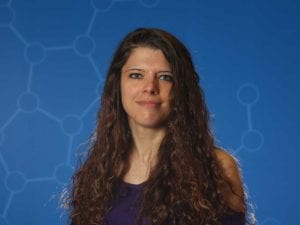By Daniel Dunaief
What if, instead of defeating or removing enemy soldiers from the battlefield, a leader could convince them to join the fight, sending them back out to defeat the side they previously supported? That’s the question Giulia Biffi, a postdoctoral researcher at Cold Spring Harbor Laboratory, is asking about a particular type of cells, called fibroblasts, that are involved in pancreatic cancer.
Fibroblasts activated by cancer cells secrete a matrix that surrounds cancer cells and makes up about 90 percent of pancreatic tumors.

Responding to a molecule called IL-1, an inflammatory potential tumor-promoting fibroblast may enhance the opportunity for cancer to grow and spread. Another type of fibroblast responds to TGF-beta, which potentially enables them to restrain tumors.
Researchers had suggested that the inflammatory fibroblasts are tumor promoting, while the myofibroblasts are tumor defeating, although at this point, that still hasn’t been confirmed experimentally.
Researchers knew TGF-beta was important in biology, but they didn’t know that it was involved in preventing the activation of an inflammatory tumor-promoting version.
Biffi, however, recently found that IL-1 promotes the formation of inflammatory fibroblasts. She believes these fibroblast promote tumor growth and create an immunosuppressive environment.
In an article published in the journal Cancer Discovery, Biffi showed that it’s “not only possible to delete the population, but it’s also possible to convert [the fibroblasts] into the other type, which could be more beneficial than just getting rid of the tumor-promoting cells,” she said.
Biffi works in Director Dave Tuveson’s CSHL Cancer Center laboratory, which is approaching pancreatic cancer from numerous perspectives.
Her doctoral adviser, Sir Shankar Balasubramanian, the Herchel Smith Professor of Medicinal Chemistry at the University of Cambridge, suggested that the work she did in Tuveson’s lab is an extension of her successful research in England.
“It is evident that [Biffi] is continuing to make penetrating and important advances with a deep and sophisticated approach to research,” Balasubramanian explained in an email. “She is without a doubt a scientist to watch out for in the future.”
To be sure, at this stage, Biffi has performed her studies on a mouse model of the disease and she and others studying fibroblasts and the tumor microenvironment that dictates specific molecular pathways have considerable work to do to extend this research to human treatment.
She doesn’t have similar information from human patients, but the mouse models show that targeting some subsets of fibroblasts impairs cancer growth.
“One of the goals we have is trying to be able to better classify the stroma from pancreatic cancer in humans,” Biffi said. The stroma is mixed in with the cancer cells, all around and in between clusters of cells.
The results with mice, however, suggest that approaching cancer by understanding the molecular signals from fibroblasts could offer a promising additional resource to a future treatment. In a 10-day study of mice using a specific inhibitor involved in the pathway of inflammatory fibroblasts, Biffi saw a reduction in tumor growth.
If Biffi can figure out a way to affect the signals produced by fibroblasts, she might be able to make the stroma and the cancer cells more accessible to drugs. One potential reason other drugs failed in mouse models is that there’s increased collagen, which is a barrier to drug delivery. Drugs that might have failed in earlier clinical efforts could be reevaluated in combination with other treatments, Biffi suggested, adding if scientists can manage to target the inflammatory path, they might mitigate some of this effect.
A native of Bergamo, Italy, which is near Milan, Biffi earned her doctorate at the Cancer Research UK Cambridge Institute. Biffi lives on a Cold Spring Harbor property which is five minutes from the lab.
When she was young, Biffi wanted to be a vet. In high school, she was fascinated by the study of animal behavior and considered Dian Fossey from “Gorillas in the Mist” an inspiration. When she’s not working in the lab, she enjoys the opportunity to see Broadway shows and to hike around a trail on the Cold Spring Harbor campus.
Biffi started working on fibroblasts three years ago in Tuveson’s lab. “I really wanted to understand how fibroblasts become one population or the other when they were starting from the same cell type,” she said. “If they have different functions, I wanted to target them selectively to understand their role in pancreatic cancer to see if one might have a tumor restraining role.”
A postdoctoral researcher for over four years, Biffi is starting to look for the next step in her career and hopes to have her own lab by the end of 2019 or the beginning of 2020.
When she was transitioning from her doctoral to a postdoctoral job, she was looking for someone who shared her idealistic view about curing cancer. Several other researchers in Cambridge suggested that she’d find a welcome research setting in Tuveson’s lab. Tuveson was “popular” among principal investigators in her institute, Biffi said. “I wanted to work on a hard cancer to treat and I wanted to work with [Tuveson].”
Biffi hopes that targeting the inflammatory pro-tumorigenic fibroblasts and reprogramming them to the potentially tumor-restraining population may become a part of a pancreatic cancer treatment.
She remains optimistic that she and others will make a difference. “This can be a frustrating job,” she said. “If you didn’t have hope you can change things, you wouldn’t do it. “I’m optimistic.”
Biffi points to the hard work that led to treatments for the flu and for AIDS. “Years back, both diseases were lethal and now therapeutic advances made them manageable,” she explained in an email. “That is where I want to go with pancreatic cancer.”





